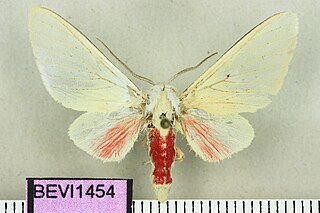
Sericoplaga is a monotypic moth genus of the family Crambidae described by William Warren in 1892. Its one species, Sericoplaga externalis, described by the same author in the same year, is found in North America, where it has been recorded from Maryland to Illinois, south to Florida and west to Texas.
Ithome is a genus of moths in the family Cosmopterigidae.

Schinia jaguarina, the jaguar flower moth, is a moth of the family Noctuidae. The species was first described by Achille Guenée in 1852. It is found on North America's Great Plains from Saskatchewan and Alberta south to Texas, eastward on coast to Florida and westward in south to Arizona. In Mexico it is found down to Mexico City.

Macrochilo louisiana, the Louisiana macrochilo or Louisiana snout-moth, is a litter moth of the family Erebidae. The species was first described by William Trowbridge Merrifield Forbes in 1922. It is found in North America from Quebec and Maine to Florida, west to Texas, north to Alberta.
Ithome concolorella, the kiawe flower moth, is a species of moth of the family Cosmopterigidae. It was first described by Vactor Tousey Chambers in 1875. It is found in the southern United States, including Texas, southern Arizona and Florida. It is an introduced species in Hawaii, where it has been recorded from Kauai, Oahu, Maui, Hawaii and Molokai.
Ithome tiaynai is a moth in the family Cosmopterigidae. It is found in northern Chile.
Ethmia notatella is a moth in the family Depressariidae. It is found in the Florida Keys, the Bahamas, Hispaniola, Puerto Rico and the Lesser Antilles (Curacao).
Macrorrhinia dryadella is a species of snout moth in the genus Macrorrhinia. It was described by George Duryea Hulst in 1892 and is known from the US state of Florida.

Eupseudosoma involutum, the snowy eupseudosoma, is a moth of the family Erebidae. The species was first described by Sepp in 1855. It is found from the southern United States (Florida) to Argentina, as well as on the Antilles.
Halysidota cinctipes, the gartered halysidota or Florida tussock moth, is a species of moth in the family Erebidae. It was described by Augustus Radcliffe Grote in 1865. It is found on Cuba, Haiti, the Bahamas and in the US states of Florida, Texas, Arizona and California. The range possibly extends through Mexico, Guatemala, Costa Rica and Panama to Venezuela, Brazil and Peru.

Virbia laeta, the joyful holomelina, is a moth in the family Erebidae. It was described by Félix Édouard Guérin-Méneville in 1844. It is found in North America from New Brunswick south to Florida and west to Minnesota and south to Texas. The habitat consists of pine woodlands.
Ithome aquila is a moth in the family Cosmopterigidae. It was described by Ronald W. Hodges in 1978. It is found in North America, where it has been recorded from Florida.
Ithome edax is a moth in the family Cosmopterigidae. It was described by Ronald W. Hodges in 1962. It is found in North America, where it has been recorded from Texas.
Ithome ferax is a moth in the family Cosmopterigidae. It was described by Ronald W. Hodges in 1962. I feraz is found in North America, where it has been recorded from Florida.
Ithome lassula is a moth in the family Cosmopterigidae. It was described by Ronald W. Hodges in 1962. It is found in North America, where it has been recorded from Florida. It was introduced into Australia by accident, where it is now found in Queensland.
Ithome simulatrix is a moth in the family Cosmopterigidae. It was described by Ronald W. Hodges in 1978. It is found in North America, where it has been recorded from Florida.
Ithome fuscula is a moth in the family Cosmopterigidae. It was described by William Trowbridge Merrifield Forbes in 1931. It is found in Puerto Rico.
Daulia magdalena, the glittering Magdalena moth, is a moth in the family Crambidae. It was described by Charles H. Fernald in 1892. It is found in North America, where it has been recorded from Alabama and Florida.

Diasemiodes nigralis is a moth in the family Crambidae. It was described by Charles H. Fernald in 1892. It is found in North America, where it has been recorded from Florida to Texas, with strays north to at least Michigan and Maryland.

Dichomeris flavocostella, the cream-edged dichomeris moth, is a moth in the family Gelechiidae. It was described by James Brackenridge Clemens in 1860. It is found in North America, where it has been recorded from southern Quebec and Maine to Florida, west to Texas and north to Manitoba.






